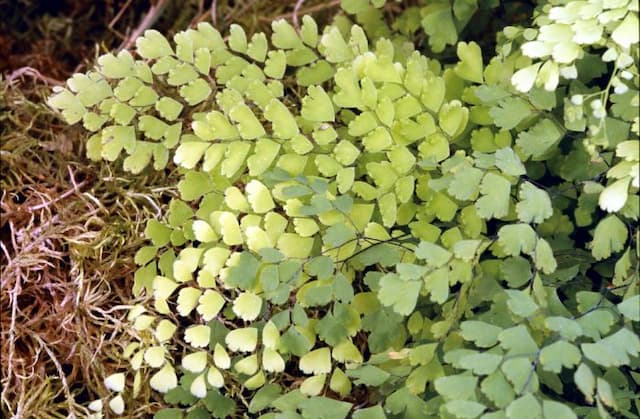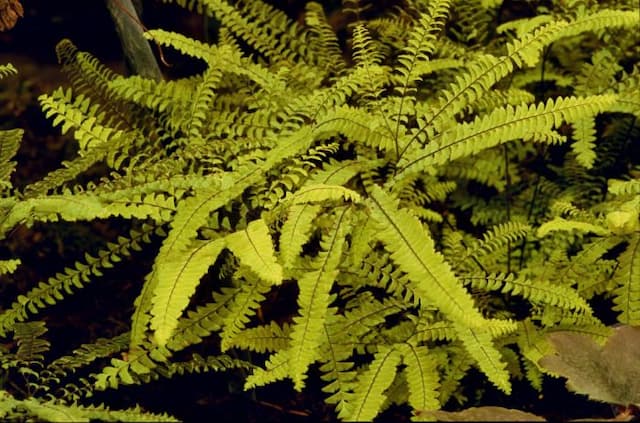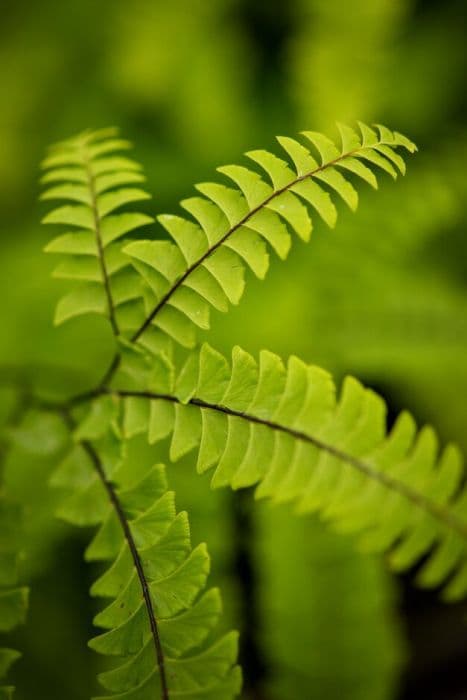Western Maidenhair Fern Adiantum aleuticum 'Subpumilum'

ABOUT
The plant known as the western maidenhair fern is characterized by its delicate, fan-shaped segments that resemble tiny leaves and are arrayed on wiry, dark stems. These segments are usually light to medium green, bringing a graceful texture to the plant's overall appearance. The stems arch gently, creating a feathery, light foliage pattern that can add elegance to any setting where the plant is cultivated. The contrasts of the dark stems against the light green foliage make the western maidenhair fern a distinctive and attractive plant. Its fronds are typically compound, meaning that each leaf is divided into multiple smaller segments, contributing to its overall lacy look. The arrangement of these segments is often referred to as pinnate, where they are organized on either side of a central axis, much like the barbs on a feather. This adds to the plant's elegant and airy appeal. The fronds emerge from a central point at the plant's base, unfurling gracefully as they mature. The western maidenhair fern thrives in moist, shady environments, which contributes to its lush appearance.
About this plant
 Names
NamesFamily
Pteridaceae
Synonyms
Western Maidenhair Fern, Aleutian Maidenhair Fern, Dwarf Western Maidenhair Fern
Common names
Adiantum aleuticum 'Subpumilum'.
 Toxicity
ToxicityTo humans
The Adiantum aleuticum 'Subpumilum', commonly known as the Western maidenhair fern, is not toxic to humans. Therefore, ingesting this plant should not cause any symptoms of poisoning or adverse health effects solely due to toxicity.
To pets
The Western maidenhair fern is also not toxic to pets. If a pet ingests this plant, it should not experience any symptoms of poisoning or adverse health consequences related to toxicity.
 Characteristics
CharacteristicsLife cycle
Perennials
Foliage type
Evergreen
Color of leaves
Green
Height
1 foot (0.3 meters)
Spread
1-2 feet (0.3-0.6 meters)
Plant type
Fern
Hardiness zones
3
Native area
North America
Benefits
 General Benefits
General Benefits- Aesthetic Appeal: Adiantum aleuticum 'Subpumilum' or Western maidenhair fern, has delicate, fan-shaped, green fronds that can provide a graceful touch to gardens and indoor spaces.
- Low Maintenance: This fern is relatively easy to care for, requiring only moderate moisture and shade, making it convenient for gardeners with varied experience.
- Shade Tolerance: Western maidenhair fern thrives in shady areas where other plants might struggle, allowing for diverse planting in different garden spots.
- Drought Resistance: Once established, it can tolerate periods of dryness, making it a resilient choice for various landscapes.
- Cold Hardy: This species is capable of withstanding colder temperatures, which makes it suitable for many temperate regions.
- Soil Versatility: It can grow in a range of soil types, provided the soil is well-draining and fertile.
- Non-Invasive: Unlike some other plants, Western maidenhair fern is not known for being invasive, ensuring that it will not overtake other plants in the garden.
- Habitat Support: Ferns like the Western maidenhair can provide necessary shelter and habitat for various insects and small wildlife.
 Medical Properties
Medical PropertiesThis plant is not used for medical purposes.
 Air-purifying Qualities
Air-purifying QualitiesThis plant is not specifically known for air purifying qualities.
 Other Uses
Other Uses- Photography: Western Maidenhair Fern can be used in macro photography to provide an intricate and delicate subject, showcasing its fine foliage and unique structure.
- Art Projects: The fronds can be pressed and used in botanical art projects or to create natural patterns in printmaking endeavors.
- Educational Tool: This plant can serve as an excellent example in educational settings to explain the lifecycle of ferns or discuss biodiversity in plant species.
- Fairy Gardens: Due to its small size and delicate appearance, Western Maidenhair Fern is a popular choice for creating fairy gardens or miniature landscapes.
- Culinary Decoration: Fronds of the Western Maidenhair Fern can be used as a natural and ornate garnish for plating high-end cuisine, though they are not edible.
- Wedding Decor: The fern's elegant appearance lends itself to be used in wedding bouquets, table arrangements, or as part of the venue's decoration.
- Textile Patterns: The distinctive leaf patterns of the Western Maidenhair Fern can inspire designs in textiles, wallpaper, and other fabric-based materials.
- Jewelry Making: The fern's silhouette can be used in the design of botanical-themed jewelry, either by imprinting its shape into metal or encasing the fronds in resin.
- Crafting Potpourri: Dried fronds can contribute to the visual appeal of potpourri mixtures, adding a natural and woodsy element to the blend.
- Aquarium Scaping: While not an aquatic plant, the Western Maidenhair Fern can be incorporated into the design of terrariums or paludariums that feature both land and water elements for a lush habitat look.
Interesting Facts
 Feng Shui
Feng ShuiThe Maidenhair Fern is not used in Feng Shui practice.
 Zodiac Sign Compitability
Zodiac Sign CompitabilityThe Maidenhair Fern is not used in astrology practice.
 Plant Symbolism
Plant Symbolism- Delicacy: The dainty and delicate fronds of the Western maidenhair fern (Adiantum aleuticum 'Subpumilum') symbolize a gentle and fine beauty.
- Purity: This plant is often associated with purity because of its pristine, airy fronds and its preference for growing in pure, uncontaminated environments.
- Secret Bond: In the language of flowers, ferns, in general, can represent secretiveness or a discreet bond, possibly due to their understated appearance among more showy plants.
- Eternal Youth: The name "Adiantum" comes from the Greek for "unwetted," referring to the fronds' ability to shed water without becoming wet, which can be seen as a metaphor for retaining one's youth or freshness.
- Refinement: With its elegant structure and graceful form, the Western maidenhair fern can symbolize sophistication and refined taste.
 Water
WaterWestern Maidenhair Fern should be watered when the top inch of soil feels dry to the touch. Provide water until it begins to drain from the bottom of the pot, typically around 8-16 ounces per week, depending on the size of the pot and the environmental conditions. In brighter light and warmer temperatures, the plant may require more frequent watering, potentially twice a week. During winter or in cooler, less bright conditions, watering can be reduced. Always ensure that the plant is not sitting in standing water to prevent root rot.
 Light
LightWestern Maidenhair Fern thrives best in bright, indirect light. Avoid placing it in direct sunlight, as the harsh rays can scorch the delicate fronds. A north-facing window or a spot that receives filtered light through sheer curtains is ideal. If growing in an office or room with limited natural light, a grow light can be used to supplement light levels.
 Temperature
TemperatureThe Western Maidenhair Fern prefers temperatures between 60 to 75 degrees Fahrenheit for optimal growth. It can survive in temperatures as low as 50 degrees Fahrenheit but should be protected from cold drafts. Ideally, keep the plant in a stable environment away from sudden temperature changes to maintain its health.
 Pruning
PruningPrune the Western Maidenhair Fern to remove any brown or damaged fronds, which will encourage healthy new growth. Pruning is best done in the spring but can be performed any time as needed. Typically, this plant requires minimal pruning; simply trim away any unsightly or dead fronds at their base using clean, sharp scissors.
 Cleaning
CleaningAs needed
 Soil
SoilThe best soil mix for Western maidenhair fern should be well-draining and rich in organic matter with a pH between 5.0 and 6.5. A mix of peat, pine bark, and perlite or pumice can be used to create an airy substrate that retains moisture while allowing excess water to drain.
 Repotting
RepottingWestern maidenhair fern should be repotted every 2 to 3 years or when it becomes root-bound. The best time to repot is in the spring, just before the growing season begins.
 Humidity & Misting
Humidity & MistingWestern maidenhair fern thrives in high humidity levels, ideally between 60% to 80%. If indoor air is too dry, use a humidifier or place the plant on a tray of wet pebbles to increase ambient humidity.
 Suitable locations
Suitable locationsIndoor
Place in bright, indirect light with high humidity.
Outdoor
Shelter from intense sun; moist, well-drained spot.
Hardiness zone
3-8 USDA
 Life cycle
Life cycleThe life of the Western Maidenhair Fern 'Subpumilum' begins with spore germination, which occurs when the tiny, dust-like spores find suitable damp, shady conditions. Following germination, the spores develop into a heart-shaped gametophyte, a small but distinct stage that houses the reproductive cells. The gametophyte stage sees the production of both sperm and egg cells; fertilization occurs when water allows the sperm to swim to the egg, resulting in a new diploid zygote. This zygote then grows into a young fern, known as a sporophyte, which is the commonly recognized fern plant. As the sporophyte matures, it develops fronds and at the underside of these, specialized structures called sori form, which carry new spores. The cycle comes full circle when these spores are released into the environment to start the process anew.
 Propogation
PropogationPropogation time
Spring-Early Summer
Propogation: The Western maidenhair fern, scientifically known as Adiantum aleuticum 'Subpumilum', is typically propagated via spore cultivation. This method is preferred due to the natural reproduction process of ferns. Spores are collected when they ripen on the undersides of mature fronds, which usually occurs during the summer months. Once collected, the spores are sown on the surface of a moist, sterile, peat-based potting mix. The cultivation container then needs to be kept in a warm place, with temperatures around 68 to 72 degrees Fahrenheit (20 to 22 degrees Celsius), and under indirect light. Covering the container with clear plastic wrap helps to maintain the necessary humidity for spore germination. It can take a couple of weeks to several months for the spores to germinate and develop into prothalli, which are the gametophyte stage of the fern.




